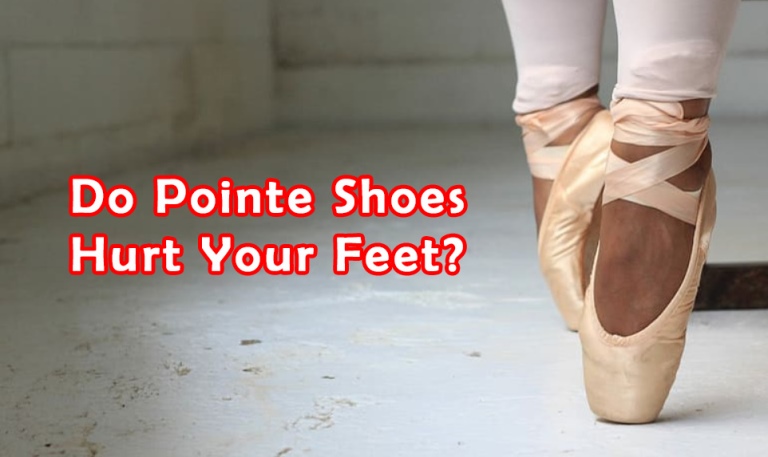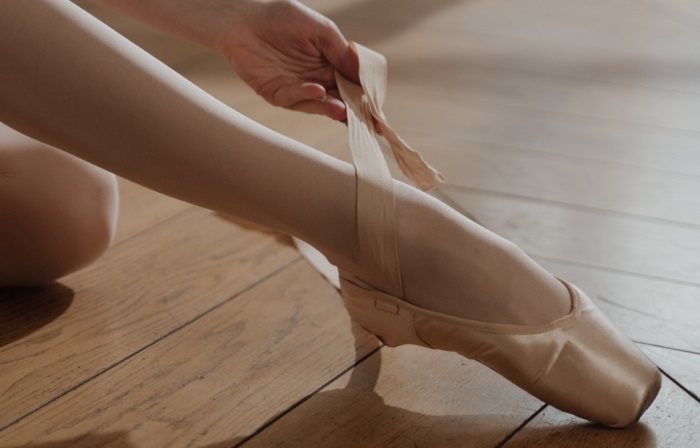En pointe is an icon in ballet.
It seems difficult even when we are only watching and thus raises the question: Do pointe shoes hurt?
How do the dancers manage to push themselves that far? Is there a secret tip for them to endure the pain and do their best on the stage?
Let’s find out!
Table of Contents
Do Pointe Shoes Hurt?
First of all, en pointe is the terminology for when the dancer shifts all their weight on the tips of their toes. It is a combination of artistry and mechanics.
If you get the steps right, you can maintain this pose without putting your body at any risk.
However, despite how much it looks like the dancer is on their toes, the technique is more complicated than that.
If you get to observe the posture from the side, you will see the instep being stretched to the maximum and perpendicular to the floor. You can draw a line from the knee to the ankle and the toes.
With such a technique, pain-free is almost an unattainable concept. It puts your body in an unnatural position and forces you to accept it.
Like other arts with strong body language, if you have a strong body, especially with the core, you can accommodate the positions more easily.
The pain is inevitable because putting your entire weight on your toes is never a relaxing task.
Beginners might not have the necessary strength and skill for en pointe but this pain is not impossible to manage.
Check more: Basic Ballet Positions With Pictures For Beginners
How Bad Do Pointe Shoes Hurt?
Aside from how strained and pressured your toes are during en pointe, the discomfort of pointe shoes is another reason en pointe is so dreadful.
To achieve this position, the muscles and bones of your feet have to be in unusual positions.
As a result, your big toe, arch, metatarsal, and ankle are all in pain due to your whole body weight sitting atop them and the shoes being extremely firm.
Their rigidity is not compatible with the straining and flexing of your feet, hence the pain never subsides.
“Good Pain” and “Bad Pain”
When you are practicing en pointe, tell the difference between the good and bad kinds of pain.
The pain is considered “good” when it contributes to your progress.
When you stretch and train your ligaments or muscles, you certainly won’t feel comfortable, though your body is getting essential improvement. With sufficient massaging and resting, you can relieve the tension and soreness.
Meanwhile, the bad pain indicates suffering from injuries.
Instead of a deep and consistent ache, you will feel sharp rushes of pain.
No soothing method will heal these injuries completely, so you will need to ask for medical care as soon as possible. If abandoned, the damage can be permanent.
Check more: How To Tie Pointe Shoe Ribbons?
How To Make Pointe Work Less Pain
Although the pain of en pointe is inevitable, especially for beginners, there are a lot of methods and tips you can use to avoid a hurting big toe or getting injured.
When you are physically and mentally ready with compatible shoes, en pointe won’t be intimidating anymore.
Prepare Your Technique
Skill is the most important aspect, and a dancer needs to be sufficiently familiar with ballet techniques before they start en pointe.
Be prepared
For a difficult and essential technique like en pointe, all students should be prepared and assessed. A talk with an experienced teacher or a physical therapist with a specialization in dancing.
With enough knowledge, you will know the expectations for your strength and skill. Hence, the risk of injuries and wrong techniques will be reduced to the minimum.
If the first assessment doesn’t work out for you, don’t be upset!
Rather than feeling down, ask for advice from your instructor and work on your flaws!
Strengthen Correctly
You can ask your instructor to come up with a program for your en pointe. It’s not only about standing up on your toes and then resting on your heels. You need to keep your lower body under control as well.
With your core being trained well enough, you can confidently perform advanced techniques while in an en pointe without worrying about injuries.
Prepare Your Pointe Shoes
Doing ballet means you can’t pick a random pair of shoes from the shelf just because it has the same size as your regular footwear!
You will need to be way more careful to ensure a perfect fit for your feet.
Get The Right Shoes
Many ballet experts would agree that finding the right shoes is the most important factor.
If you are a young dancer whose feet are still growing, you need a proper fitter with various styles.
Once you reach adulthood and have a fixed measurement, you can purchase pointe shoes online.
So, how do you know if the shoes fit you right?
Believe in what your body says. It should feel tight around your toes but not to the point of squashing them together.
If the box is too loose, your feet will slide downwards and send all the pressure to your toes.
Remember that our feet are not the same. There won’t ever be an ideal shoe that fits everyone.
Even if you feel comfortable with a brand that no one else uses, don’t hesitate to go for it!
Check more: Canvas Ballet Shoes Vs Leather: Which Is Your Best Choice?
Choose The Shoes For Your Level
In ballet, the difference between a beginner and a professional is massive. And the dancewear for each of them also varies.
When you first start with en pointe, you will most likely practice at the barre. With its support, you only need soft shoes to arrange your feet correctly.
It was not until you started to learn and incorporate more complex moves into your routine did you need firmer footwear, for it will be extremely stressful on the toes.
Once you are going for the advanced en pointe, you will gradually be more familiar with having several pairs of shoes at once.
Supple shoes are for barre training and Romantic solos. Meanwhile, stable shoes are for variations and hops.
Keep Your Shoes Strong
Most ballet shoes now come with removable padding as an encouragement for the users to frequently remove and dry them. Moisture from perspiration can weaken the glue bond and ruin the middle structure.
Aside from maintenance, you should also have several pairs of shoes and pads to cycle through the week. The more often you do en pointe, the more you need to keep your shoes healthy.
If the shank feels too soft, using glue can give it some more stiffness.
It’s also crucial to know that pointe shoes can have multiple stages.
At first, they can be performance shoes in prime conditions. After some time has passed, they will be more suitable for class and exercise while new shoes take over their role.
Once the shank is out, they become demi-pointe shoes. It’s part of the mentioned advice about using the right shoes.
Pre-Weaken Your Pointe Shoes
Pre-weakening has a more general alternative: break-in. It’s the progress of weakening selected spots in your shoes so the shank will be fine.
Unlike in the old days, we shouldn’t cut or do anything to the shank in modern ballet shoes.
What you need to focus on is the demi-pointe area and the heel because it allows you to rise accurately while having enough support for the arch.
We have different foot structures. Hence, the most effective way to pre-weaken our pointe shoes is by measuring the breaking point of your feet and weakening it.
We don’t recommend weakening the pointe shoes based on your feelings, as it might not end up with the shank flat against your foot’s arch.
Furthermore, it will look and feel not as good as it could be.
Take Care of Your Feet
There are two aspects you need to pay more attention to a hygienic environment for your feet and the correct articulation while practicing.
Look After Your Feet
Since your feet will be under so much pressure, maintaining a good hygiene regime is the most basic thing to do.
According to professional ballerinas, they never let their toenails grow too long. Pedicure is also out of their list because it affects calluses and cuticles, which are responsible for protection against infection.
Good hygiene for feet also saves you from blisters and other nasty issues, for practicing ballet results in heavy sweating. If you don’t remove the toe pads and wash them regularly, the pain is inevitable.
Recently, many ballet dancers have been into foot sprays. The recipe is pretty simple: ¼ water, ¾ rubbing alcohol, and a few drops of your favorite essential oils.
You can spray your feet after practice to get rid of bad odors and bacteria as long as you don’t have any open wounds.
Use Appropriate Padding
Ample padding might seem promising and tempting but what you need is minimum materials under your toes. Excessive padding can interrupt the placement of your feet.
Instead of trying to lessen the unpleasant rubbing against the shoes, it is advisable to train and strengthen the articulation so your muscles will be in a proper position.
Your toes should be straight and not clawing at the inside of the shoes since clawing means your long toe is being used incorrectly.
Its flexor muscle can put an undesirable impact on the ankle and lead to permanent soreness.
What If The Pain Is Persistent
As we have said, pain is not avoidable if you decide to commit to doing an en pointe. Even a demi-pointe hurts! Though it shouldn’t feel like you have to ruin your feet.
If the pain is sharp and permanent when you have done everything accurately, there might be something more serious. In this case, you should consult with someone professional about health and try to express your conditions.
Truthfully, telling them that your pointe shoes damage your feet or cause bunions and doing nothing about it is not the solution. You can have control over the situation by changing your shoes and honing your skills.
Even if all of your friends are using the same brand for pointe shoes, it doesn’t mean you have to follow them.
Likewise, a nice picture on the internet shouldn’t give you the impression that you can do the same without pushing your limits.
No Pain, No Gain!
In conclusion, it’s hurt to wear pointe shoes no matter how good you are and how long you have practiced them.
The position itself is a challenge for our bodies but the pain shouldn’t stop you from attempting a perfect en pointe.
Instead of focusing too much on physical discomfort, try to think of the accomplished feeling when you succeed!
Furthermore, don’t forget to determine whether the pain is good or bad and get the necessary care in time!

